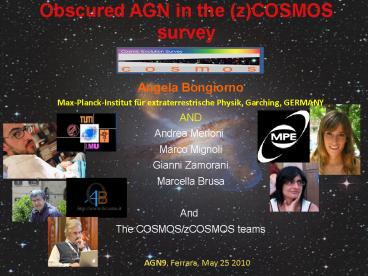Obscured AGN in the (z)COSMOS survey - PowerPoint PPT Presentation
Title:
Obscured AGN in the (z)COSMOS survey
Description:
... COSMOS survey Complete census of ... Hierarchical growth Growth of SMBH Gas inflow AGN feedback Active Quasar Starburst & buried Quasar Normal galaxies Galaxy ... – PowerPoint PPT presentation
Number of Views:143
Avg rating:3.0/5.0
Title: Obscured AGN in the (z)COSMOS survey
1
Obscured AGN in the (z)COSMOS survey
Angela Bongiorno Max-Planck-Institut
für extraterrestrische Physik, Garching,
GERMANY AND Andrea Merloni Marco Mignoli Gianni
Zamorani Marcella Brusa And The COSMOS/zCOSMOS
teams
AGN9, Ferrara, May 25 2010
2
Starburst buried Quasar
Galaxy mergers
Gas inflow
Hierarchical growth
Growth of SMBH
AGN feedback
Active Quasar
Normal galaxies
- Complete census of AGN (in particular
- obscured population)
(adapted from Hopkins et al., 2008)
- How obscured AGN evolve
- Fraction of obscured AGN (as a
- function of e.g. L and z)
3
THE COSMIC EVOLUTION SURVEY
- 2 deg2 equatorial
- HST treasury project
- Deep ACS iAB lt 27
- Multi-wavelength observations
- Similar volume as SDSS, but fainter and higher z
- 19-band photo-z
RA 100028.6 Dec 021221
4
Multi-wavelength Data
XMM
HST
- VLA 1.4 GHz 7 µJy
- Spitzer-IRAC 3-8 µm 10 µJy
- Spitzer-MIPS 24 µm 15 mJy
- HST-ACS iAB27
- Subaru Bvriz mAB27
- GALEX N/F UV mAB26
- XMM 0.5-10 keV 10-15 cgs
- Chandra 0.5-2 keV -- 2x10-16cgs
Chandra
Spitzer
VLA
Subaru
5
SPECTRA the z-COSMOS project
VIMOS _at_VLT
P.I. S. Lilly zCOSMOS Institutes ETH Zurich LAM
Marseille LAOMP Toulouse INAF Milano INAF
Bologna MPE Garching
VIMOS _at_VLT
- 600 hrs of observation with VIMOS on VLT started
April 2005 - Spectra will be obtained for
- 20,000 galaxies at 0.3 lt z lt 1.0 selected to
have IABlt22.5 - (BRIGHT SAMPLE)
- 10,000 galaxies at 1.4 lt z lt2.5 with BABlt25 and
chosen by color-selection criteria (DEEP SAMPLE) - Extra targets from XMM, GALEX and radio
catalogue
6
OIII Line Luminosity Function I Comparison with
other surveys
SDSS type2 (Reyes08) local LF SDSS (Hao05)
XLF XMM-HBS (DellaCeca08) COSMOS X-ray LF
Luminosity-dependent density evolution (LDDE)
?12.13 ?20.5 L1.1 1041 ?2.55 10-5
(Bongiorno, Mignoli, Zamorani et al., 2010 AA
510, 56B)
7
Fraction of type-2 AGN
SDSS (Reyes08) zCOSMOS
- at LOIII gt Lc, decreasing fraction of type2
AGN with luminosity
- 0.15lt z lt0.3 from 65 to 50 from LO
III106.2 -108.2 L? to 108.2-109.2L?
- 0.3lt z lt0.45 and 0.5lt z lt0.92 from 80 to 25
from LO III 106.2-108.5L? to LO
III109.0-109.6L ?
- What happen at LOIII lt Lc?
(Bongiorno, Mignoli, Zamorani et al., 2010 AA
510, 56B)
8
BH accretion as a function of galaxy properties
SDSS type-2 AGN sample _at_zlt0.3 (Kauffmann
Heckman 2008)
Eddington ?Log(LOIII/MBH) 1.7
2 Edd
Feast Galaxies rich in cold gas BH growth is
regulated by small-scale feedback.
Famine Galaxies poor in cold gas. BH accretes
0.3 - 1 of the mass lost by evolved bulge
stars.
9
BH accretion and star formation at higher
redshift using the 20k zCOSMOS type-2 AGN sample
? 392 sources _at_ z1 (close to the peak of the
cosmic AGN and star formation density)
- AGN hosts masses through SED fitting
Separate the Spectral Energy Distribution of AGN
into nuclearhost components and derive the host
properties
- AGN templates
- - Elvis et al. (1994)
- - E(b-v)0 - 0.3 in 0.01 steps
- Galaxy templates
- - 14 phenomenological
- from Polletta (2007)
- - Libr. of synthetic sp.
- (Bruzual Charlot)
- a) 10 declining SFH
- SFR ?e-t/?
- ?0.1-30 Gyr
- tage50Myr-5 Gyr
- tagelttuniv(z)
- 0 lt E(B-V) lt0.5
- b) 1 constant SF
Used Bands 6 SUBARU bands K band (CFHT) 4
Spitzer/IRAC 24?m Spitzer/MIPS
Red/Purple Galaxy template Blue AGN template
(Merloni, Bongiorno et al. 2010 ApJ 708, 137M)
10
BH accretion and star formation at higher
redshift
- Computation of the BH Masses
SED fitting ? M ? (scaling relation) ?
BH masses
( Bongiorno, Merloni et al. in prep)
11
Using the sSFR to distinguish old and young
galaxies
(391)
0.02Edd
0.6Edd
( Bongiorno, Merloni et al. in prep)
12
Using the sSFR to distinguish old and young
galaxies
Dotted lines OIII completeness limit
Gradual trend towards lower Eddington ratios with
older stellar population content. However
selection effect still to be fully accounted for
( Bongiorno, Merloni et al. in prep)

